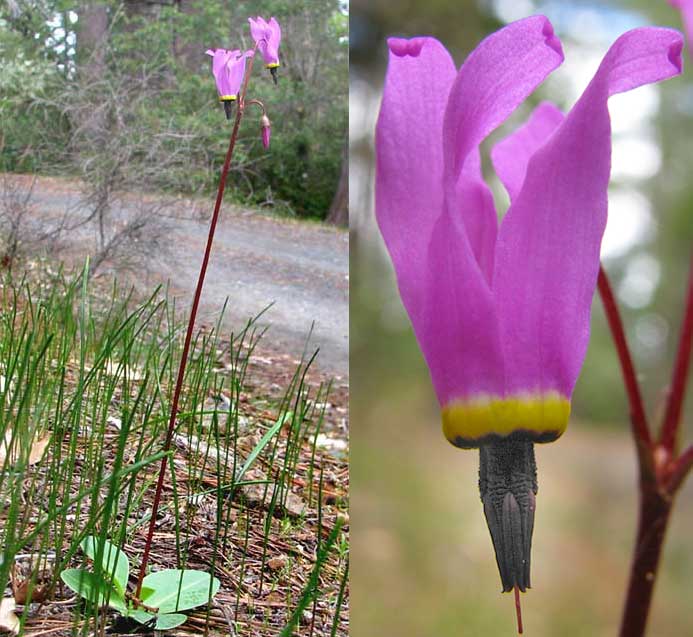Excerpts from Jim Conrad's
Naturalist Newsletter

from the the April 13, 2009 Newsletter, issued from Siskiyou National Forest west of Grants Pass, Oregon:
HENDERSON'S SHOOTING STAR
Approaching my new base on the one-lane gravel road snaking up and up a mountainside, through the car-door window I was gratified to see wildflowers blooming on the wet, spongy, deeply shadowed forest floor. Though abundant, they were "classic" wildflowers, nothing weedy or plain-looking about them, with showy, violet- pink blossoms nodding on slender stems arising from rosettes of glossy, waxy leaves. You can see one above.
That's the Henderson's Shooting Star, DODECATHEON HENDERSONII*, and you can see that its blossoms are something special. First, the flowers dangle from recurved stems so that what's usually the flower's "top" -- stamens, the slender style tipped with its stigma -- points earthward. Therefore, the blackish items at the bottom of the picture are grown-together male stamens while the slender thing projecting downward from the center of the cylinder the stamens form is the feminine, stigma-tipped style. The five violet-pink corolla lobes "should" curve downward cupping the sexual parts inside them but instead curve backward and upward.
In the Northern Hemisphere if you see a vibrantly colored flower like this with a yellowish center and starkly pigmented anthers and stamens arising opposite the corolla lobes, not alternating with them, a good first-bet is that you have a member of the Primrose Family, the Primulaceae, and that's the case here.
To confirm that the stamens arise opposite the corolla lobes you need to know that the filament -- the sticklike stem holding the anther -- is roughly wrinkled crosswise and its tissue extends up between the stamen's two anther-halves. The anther-half, or locule, of one stamen touches the anther-half of the contiguous stamen.
Henderson's Shooting Stars occur from California north to southern British Columbia and Idaho. It is "summer deciduous," which means that during the soon-to-arrive summer dry season it'll die back to the ground.